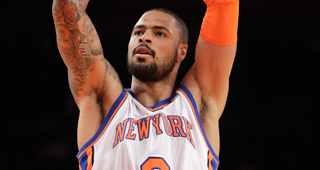In December of 2011, then-acting New York Knicks general manager Glen Grunwald made a bold move that changed the landscape of the roster. Grunwald amnestied point guard Chauncey Billups and facilitated a three-team, sign-and-trade deal that brought Tyson Chandler to the Knicks.
Grunwald and former head coach Mike D'Antoni assembled one of the top NBA frontcourts on paper with Chandler at center, Amar'e Stoudemire at power forward, and Carmelo Anthony at small forward.
Last season, Chandler gave the Knicks a great return on the first year of his $58 million contract. Chandler won the NBA Defensive Player of the Year Award and led the Knicks in rebounds and blocks.
Chandler was the defensive captain, putting his teammates in the correct positions by calling out switches on pick-and-rolls. Chandler allowed the guards beyond the arc to gamble for steals as he patrolled the paint. The gambles paid off for the Knicks as they finished second in the NBA in steal percentage (10.37).
However, Chandler became ill with the flu during the playoffs and was a non-factor in New York’s first-round matchup against the Miami Heat. With Chandler at less than 100%, and no true backup center, the Knicks struggled to contain Chris Bosh and allowed numerous uncontested drives by LeBron James and Dwyane Wade. The Knicks ultimately fell to the Heat in five games and were outscored by 70 points.
This summer, Grunwald added a veteran backup center that could replace Chandler in case of an injury or foul trouble, and provide the same defensive intensity. The Knicks traded Toney Douglas, Josh Harrellson, Jerome Jordan, and two future second-round draft picks to the Houston Rockets for center Marcus Camby.
Grunwald’s pairing of Chandler and Camby is the most efficient NBA center tandem on paper.
At 29, Chandler is the reigning Defensive Player of the Year and is an underrated offensive center. Chandler led all NBA players in true shooting percentage (.708), effective field goal percentage (.679), and had the second highest offensive rating (129.2).
At 38, Camby led the NBA in total rebound percentage (18.95) and defensive rebound percentage (26.89).
Camby’s rebounding will be a welcome addition to New York’s frontcourt after finishing 23rd in total rebounding percentage (40.91) last season.
Camby’s arrival also lessens the pressure on Chandler to own the paint each game. Chandler snatched one-third of New York’s rebounds and swatted 49 percent of the team’s blocked shots.
With the combination of Chandler’s defensive signal-calling, his league-leading offensive efficiency, and Camby’s league-leading rebounding, the Knicks have the most efficient center tandem on paper on both sides of the court.
Grunwald hopes the pair looks as good on the court as it does on paper. Chandler and Camby are both signed with the Knicks for the next three years.


